American Traditional or Old School tattoos are powerful expressions of identity and heritage. Their timeless designs are steeped in history, capturing the essence of American culture since they first appeared in the 20th century.
If you want to carry the ink that resonates with you on a deeper level, bold lines and distinctive shading of American traditional tattoos might be what you were looking for.
The Origins of American Traditional Tattoos
Tattooing is an ancient art form, and evidence of its practice has been found across many cultures for thousands of years. Ötzi the Iceman, a preserved 5,300-year-old mummy discovered in the Alps, had tattoos marking his body — one of the earliest known examples of tattooing (Smithsonian Magazine) (1).
However, tattoos did not gain widespread popularity in America until the late 19th and early 20th centuries, when they appeared more frequently on sailors, soldiers, and circus performers (Jean-Chris Miller, “The Body Art Book,” 1997) (2).
Early on, body art was primarily reserved for circus folk and sailors. In fact, many of the circus entertainers with tattoos were former mariners. Others joined because they had tattoos.
After lengthy voyages, sailors would return with new tattooing techniques and designs they discovered. Given the dangers of sailing during this era, tattoos also served as a simple method for identifying lost bodies
The Rise of Tattoo Parlors
O’Reilly, whose primary clients were seafarers, once said, “A sailor without a tattoo is like a ship without grog: not seaworthy” (New Zealand Maritime Museum, 2023) (4).
Soon after, many more tattoo shops appeared, particularly near port towns, to welcome the sailors who would rush out after payday to get their tattoos (Dismantle Magazine) (5). The US Navy even included tattoos in recruitment posters during the 1940s (Collectors Weekly, 2012) (6).
At this time, flash designs became the preference of tattooists due to their speed of completion. Parlors would offer a limited range of colors and a small number of designs, with little customization available for patrons.
In 1902, an article from the New York Tribune demonstrated how tattoos were becoming more mainstream (Scott Boersma, “Tattoos, American Sailors, and US Maritime Communities”) (7).
The paper featured an interview with a local tattoo artist detailing the broader public’s growing concerns about the permanency of tattoos and whether children might engage in the practice. At this point, some tattooists began seeing their work as an expression of art.
Icons of Ink: Sailor Jerry, Ed Hardy, and the Rise of American Tattoo Art
In the 1930s, the renowned tattoo artist and Navy veteran Norman Keith Collins made his mark in the world of tattooing. More commonly known as Sailor Jerry, Collins learned how to tattoo from a Filipino-Hawaiian tattooer. Sailor Jerry is often credited with turning tattoos from a craft into an art.
He experimented with pigment and technique, combining Japanese, American, and European stylistic elements. His methods and designs heavily influenced the traditional American tattoo style.
Another recognizable tattoo artist who appeared during the 70s was Ed Hardy, who began his apprenticeship under Sailor Jerry in 1969 (Ed Hardy, “Wear Your Dreams: My Life in Tattoos,” 2013) (8).
In his autobiography, Hardy referred to Sailor Jerry as “the greatest tattooer of his generation.” Hardy opened his own tattoo parlor, Realistic Tattoo, in 1974. He claims his “fingerprints can be found on every wrinkle in the worldwide [tattoo] movement … I watched the entire world get tattooed.”
Hardy noted that while his original customers were those from the fringes of society, the “practice of tattoos oozed from there into the mainstream culture over the next twenty years.”
The rise of Old School tattoos, regardless of their origins, has left a rich historical narrative that inspires many contemporary designs. Interestingly, classic tattoos appear to be gaining popularity among today’s tattoo enthusiasts.
During his interview with Collectors Weekly, C.W. Eldridge, a tattoo historian and artist trained under Ed Hardy, suggests that prominent brands like Ed Hardy’s merchandise and Sailor Jerry’s rum have had a “tremendous effect on the current popularity of traditional tattooing.”
Lodder adds, “Traditional American designs are steeped in romance and come with a combative rhetoric of tradition, lineage, craftsmanship, and cultural memory, as well as a loudly defended sense of what tattooing is, and what it should be.”
Key Elements of American Traditional Tattoo Style
Old School tattoos feature a vintage, nostalgic element in their characteristic designs. The first defining feature of this type of tattoo is dark, bold, clean lines. These lines allow the tattoo to stand out while ensuring that it remains long-lasting, and, according to Inked Magazine, the palettes lend themselves effectively to all skin tones (9).
Alongside the striking black lines, these tattoos feature vivid hues. The primary colors are typically used most, though greens and browns also appear. These tattoos feature minimal shading, focusing instead on bright, saturated colors.
Ultimately, an Old School tattoo design should have a dramatic impact.
Despite the simplistic designs, the process of inking this type of tattoo is quite complex.
To achieve this iconic style, tattoo artists must use a steady hand to draw clean, precise lines. Together with these lines, the vivid hues must be heavily saturated with more ink tattooed under the skin than other tattoo styles.
Iconic Symbols of American Traditional Tattoos
Among the many representative designs for Old School tattoos, a few stand out as quintessential to the style.
Anchors
Anchors symbolize a sailor’s relationship with the sea and their promise to return home safely. They also represent stability, grounding, and a strong foundation. Additionally, anchors can signify a successful Atlantic crossing.
Swallows
For sailors, swallows represent traveling approximately 5,000 nautical miles (The Historic Dockyard, Chatham) (10). Due to the bird’s long migration patterns, the swallow symbolizes a sailor’s safe return home after extended voyages. The swallow also signifies hope and freedom.
Daggers
Daggers hold multiple meanings within this type of tattoo. According to Honorable Society, they often represent courage, strength, protection, justice, and honor (11). They are also frequently used as a reminder that tomorrow is never promised and that each day should be lived to the fullest.
Hearts
Roses
Like a heart, red roses represent romantic love and passion. However, other colors of roses can signify different emotions. For example, a white rose often conveys purity.
Pin-Up Girls
Sailors were often away for significant periods. Unsurprisingly, they had glamorous pin-up girls, often in provocative poses, as tattoos. Pin-up girls celebrated women’s beauty, charm, and confidence.
20 Classic-Inspired Tattoo Ideas
Explore 20 modern twists and classic interpretations of iconic American traditional designs. These tattoos blend traditional stylistic elements — bold lines and saturated colors — with unique imagery.
This post may includeaffiliate links.
Perfect for a pair of ripped jeans, these double knee tattoos feature a light and dark version of a big cat. Similar to the bear, large cats — like panthers and tigers — represent physical strength, courage, determination, and victory.
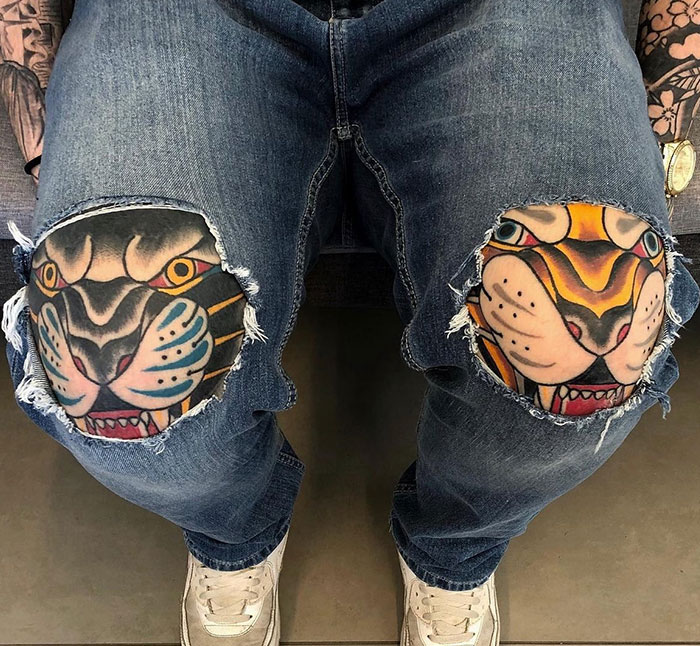
RELATED:
This vampire bat embodies the elements of an American traditional design, featuring primarily thick, black lines and bright red blocking.
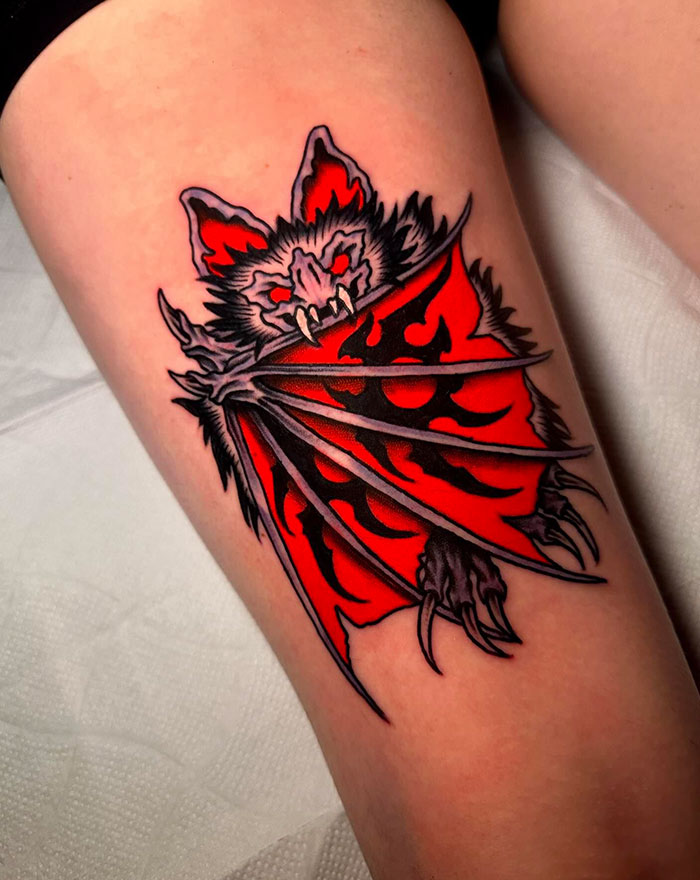
Like their aquatic counterparts, octopuses in traditional American designs represent acumen, ingenuity, and adaptability. This tattoo features the precise black lines of this style but deviates slightly from the typical color palette.
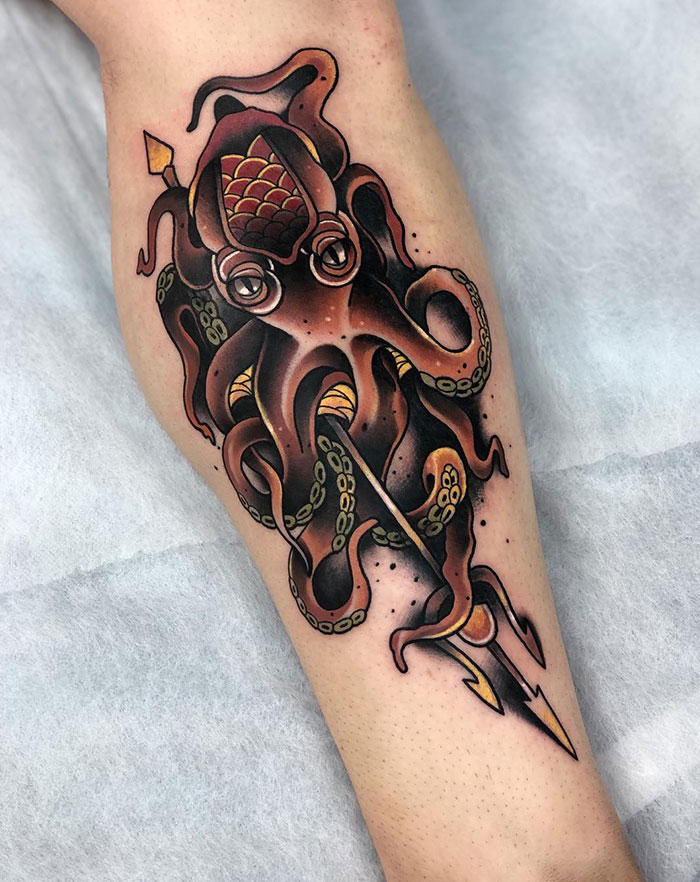
Bears are symbolic of both resilience and inner strength, as well as physical strength. This striking tattoo features strong black lines and vivid hues.
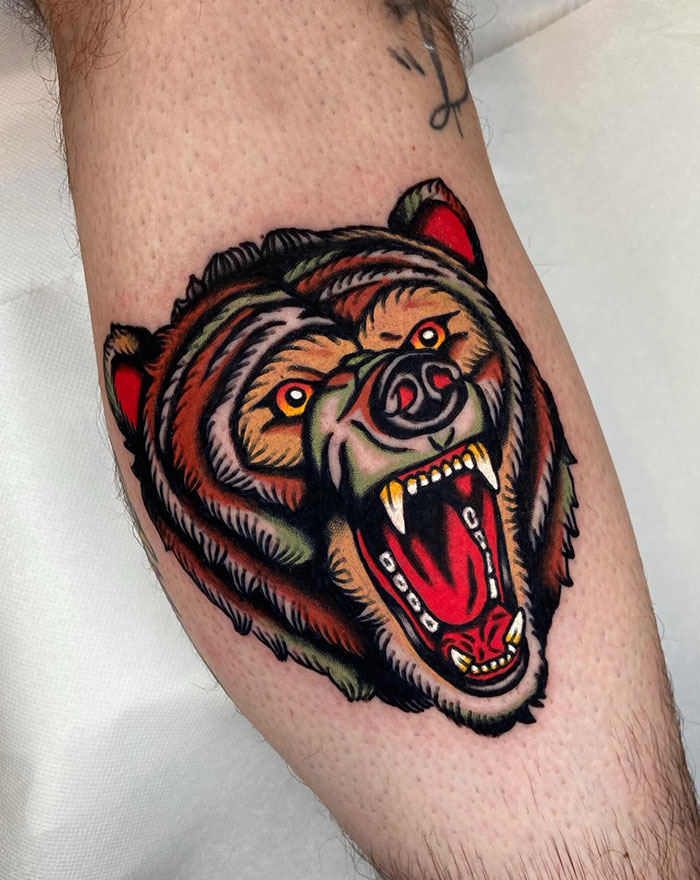
A design centered around the Japanese maneki-neko — a symbol of prosperity and good fortune.Precise black lines encase deep red, green, and yellow.
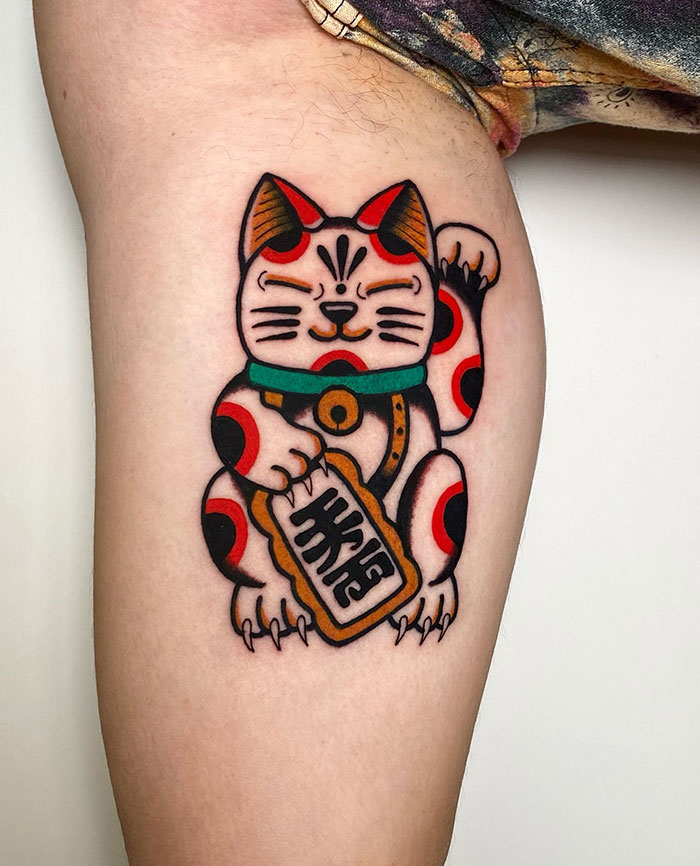
While death moths aren’t a typical image used for this style, the striking hues and clean lines are. Death moths often represent transformation and change.
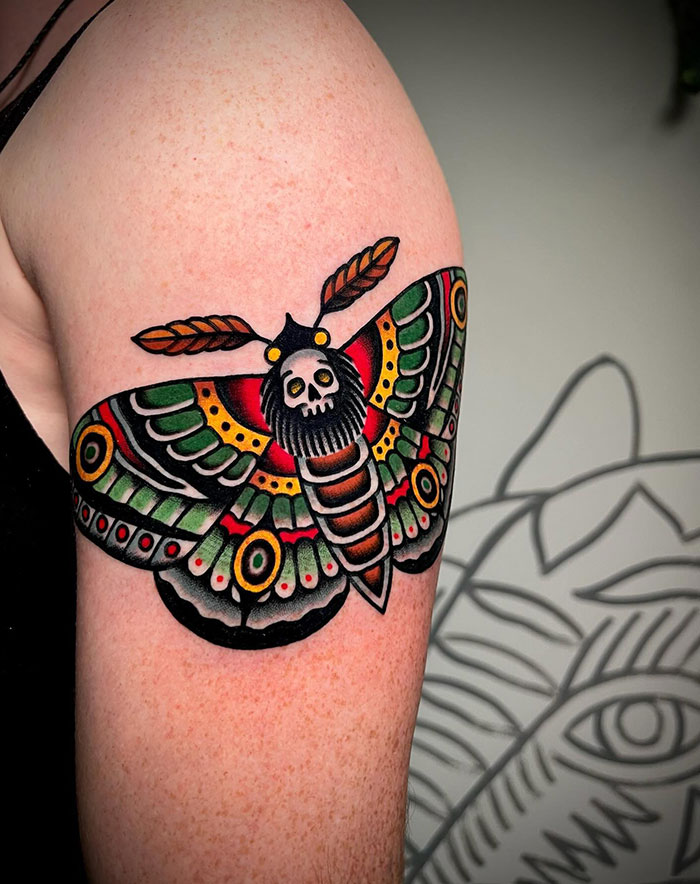
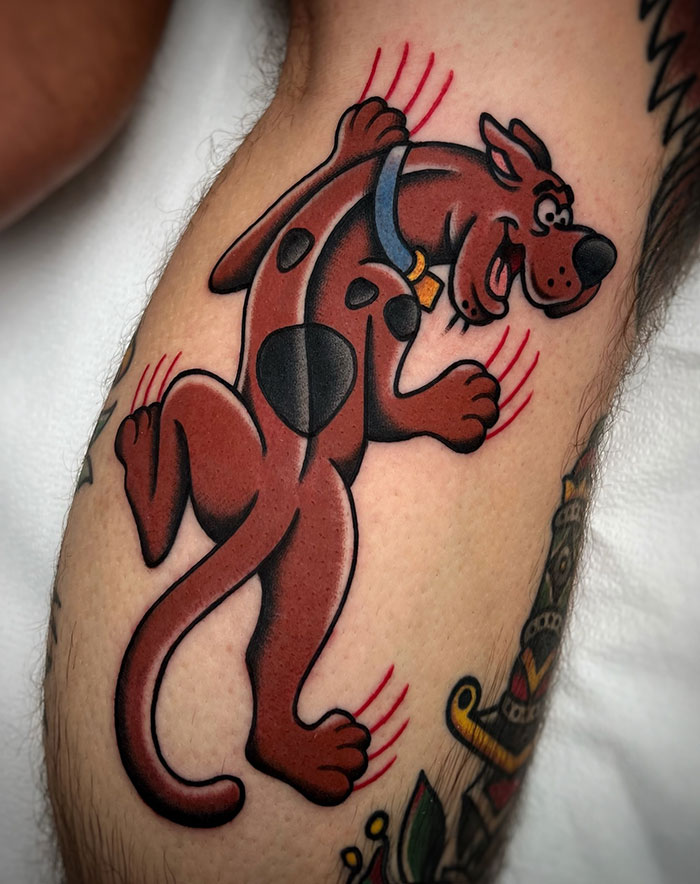
A brightly colored duck with precise black lines.
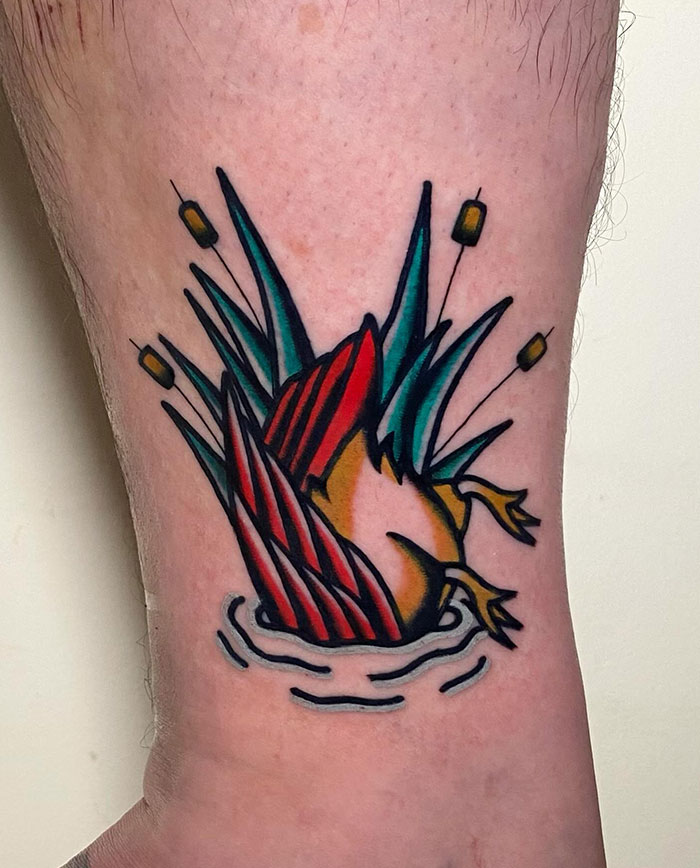
Cacti aren’t typically associated with traditional American tattoos. However, the artistic elements and skull are. Skulls represent courage, protection, rebellion, and transformation. Similar to daggers, they, too, symbolize the brevity of life.

A simplistic, clean, and vivid rose design on each shoulder.
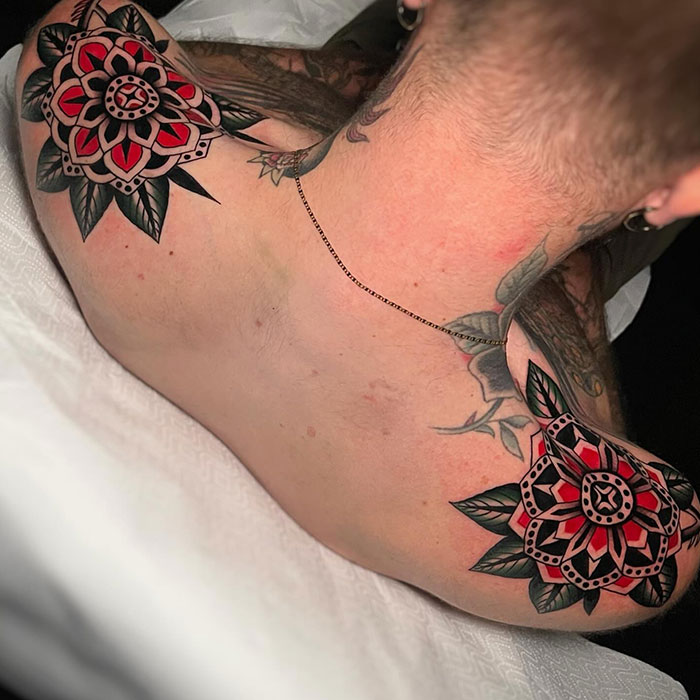
A modern and spooky take on a classic pin-up girl tattoo. The pin-up ghost in the tattoo even sports her own body art!
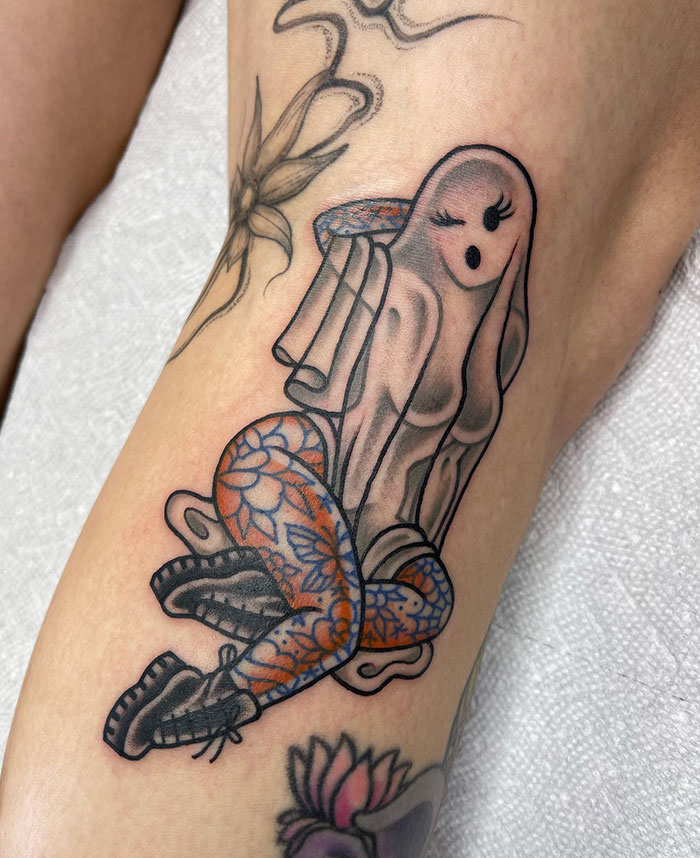
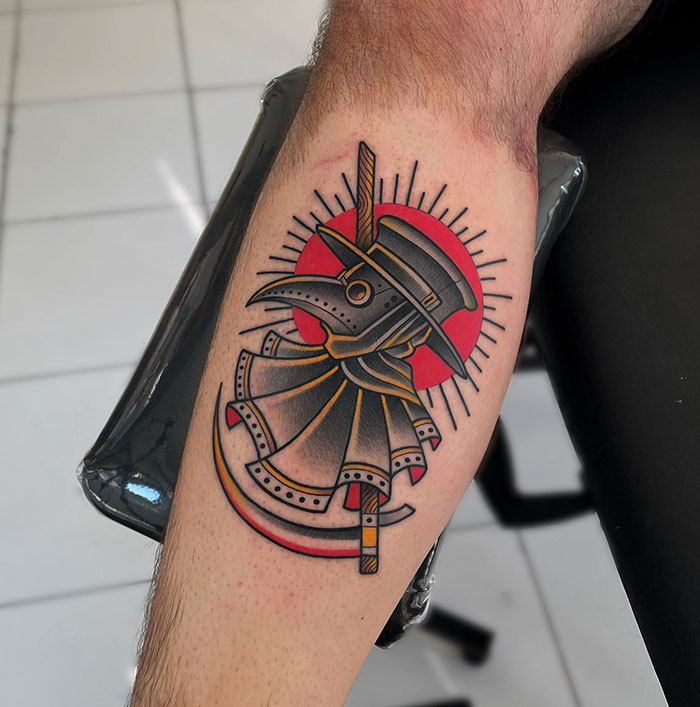
Both the frog and snake could represent transformation. A snake is usually a metaphor for shedding the old and embracing the new.
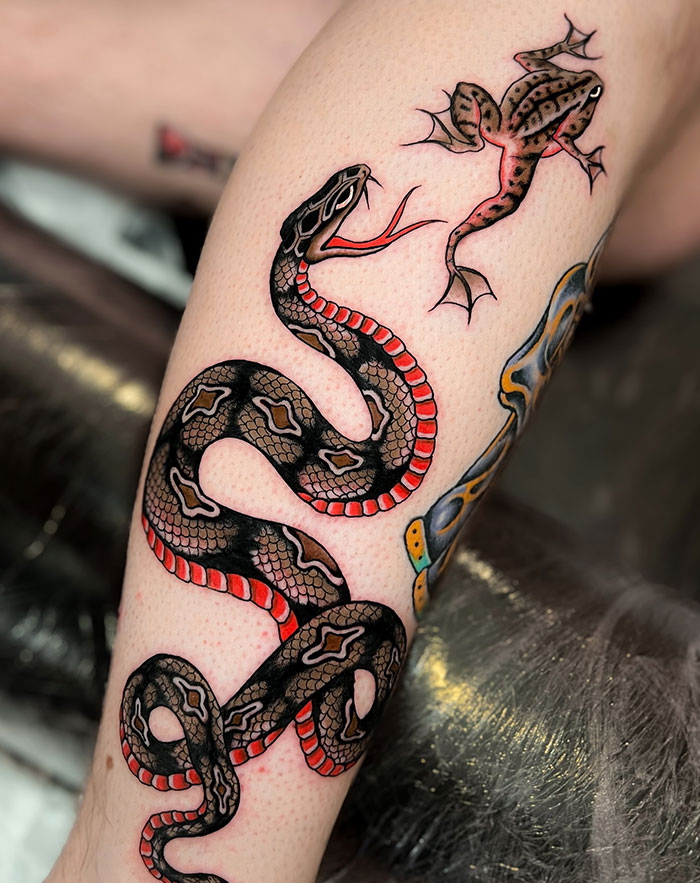
See Also on Bored Panda
Similar to the bear and large cats, wolves represent strength. However, wolves also symbolizefamilial bonds.
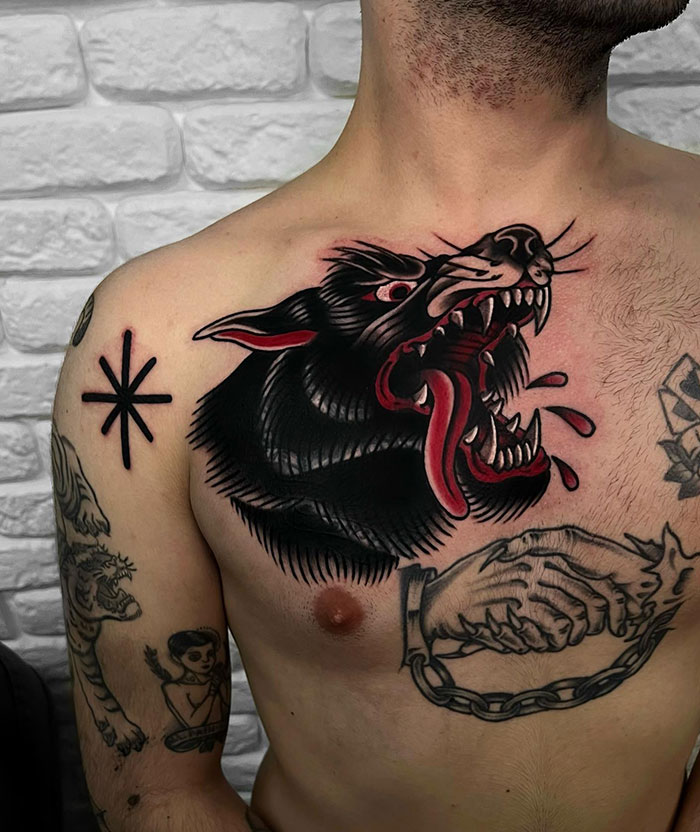
A beautiful, clean design featuring precise lines and bright hues. Oranges commonly symbolize sound health and vitality.
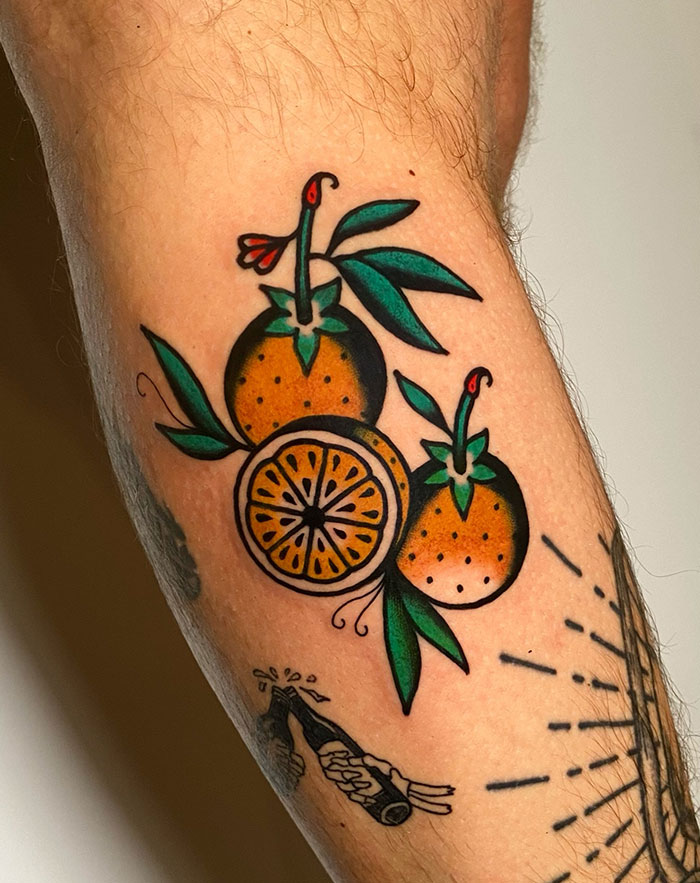
Vivid red hearts set against the sleek body of a panther.
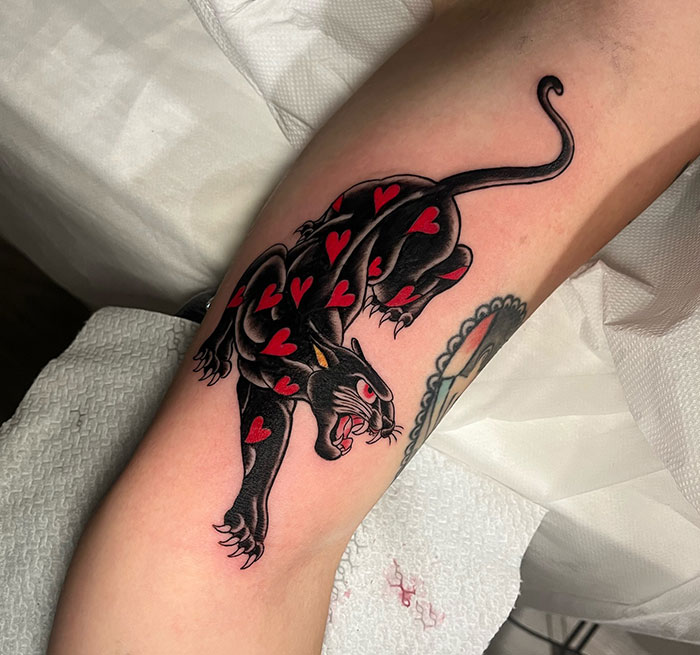
The ultimate dedication to footwear with a classic Old School design.
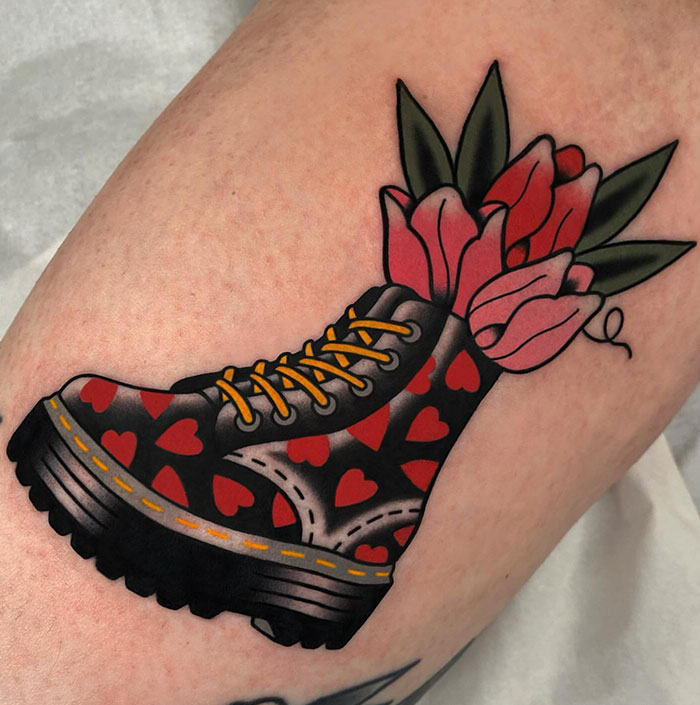
A stunning red rose with intricate lines.
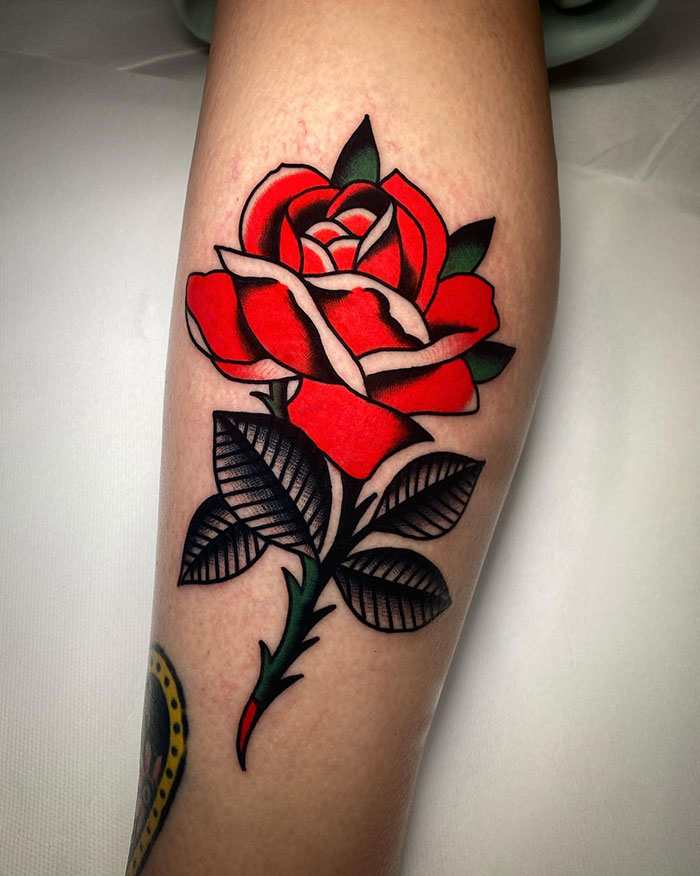
Whales typically represent strength, emotional depth, intelligence, freedom, and protection. The design features a skeleton, which, like a skull, could express the fragility of life.
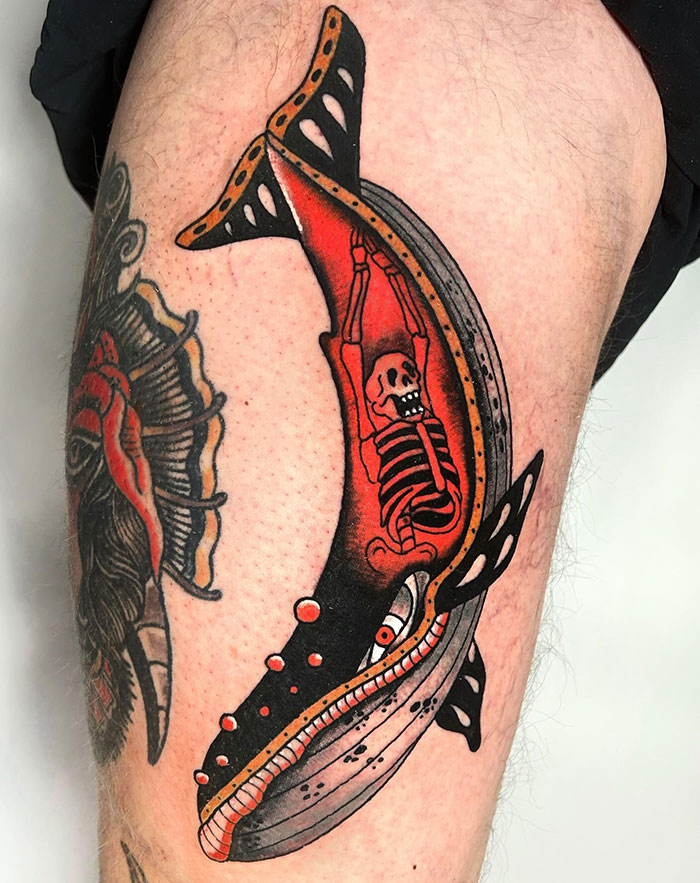
A unique design with bright red and yellow alongside distinct lines.
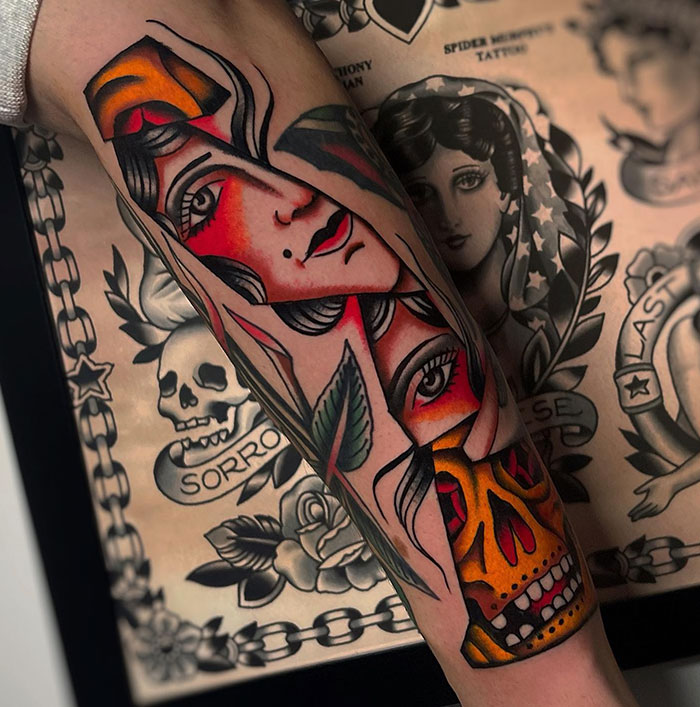
FAQ
Are traditional tattoos Native American?
References
Modal closeAdd New ImageModal closeAdd Your Photo To This ListPlease use high-res photos without watermarksOoops! Your image is too large, maximum file size is 8 MB.Not your original work?Add sourcePublish
Modal close
Add New ImageModal closeAdd Your Photo To This ListPlease use high-res photos without watermarksOoops! Your image is too large, maximum file size is 8 MB.Not your original work?Add sourcePublish
Modal closeAdd Your Photo To This ListPlease use high-res photos without watermarksOoops! Your image is too large, maximum file size is 8 MB.Not your original work?Add sourcePublish
Add Your Photo To This ListPlease use high-res photos without watermarksOoops! Your image is too large, maximum file size is 8 MB.
Add Your Photo To This List
Please use high-res photos without watermarks
Ooops! Your image is too large, maximum file size is 8 MB.
Not your original work?Add source
Modal closeModal closeOoops! Your image is too large, maximum file size is 8 MB.UploadUploadError occurred when generating embed. Please check link and try again.TwitterRender conversationUse html versionGenerate not embedded versionAdd watermarkInstagramShow Image OnlyHide CaptionCropAdd watermarkFacebookShow Image OnlyAdd watermarkChangeSourceTitleUpdateAdd Image
Modal closeOoops! Your image is too large, maximum file size is 8 MB.UploadUploadError occurred when generating embed. Please check link and try again.TwitterRender conversationUse html versionGenerate not embedded versionAdd watermarkInstagramShow Image OnlyHide CaptionCropAdd watermarkFacebookShow Image OnlyAdd watermarkChangeSourceTitleUpdateAdd Image
Upload
UploadError occurred when generating embed. Please check link and try again.TwitterRender conversationUse html versionGenerate not embedded versionAdd watermarkInstagramShow Image OnlyHide CaptionCropAdd watermarkFacebookShow Image OnlyAdd watermark
Error occurred when generating embed. Please check link and try again.
TwitterRender conversationUse html versionGenerate not embedded versionAdd watermark
InstagramShow Image OnlyHide CaptionCropAdd watermark
FacebookShow Image OnlyAdd watermark
ChangeSourceTitle
Art